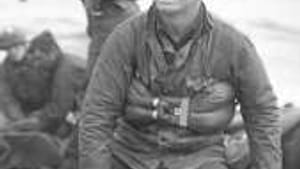Stay in the Loop
BSR publishes on a weekly schedule, with an email newsletter every Wednesday and Thursday morning. There’s no paywall, and subscribing is always free.
Hitler's defeat: The ultimate human drama
"Guns at Last Light': Hitler's defeat

Rick Atkinson's first book, The Long Gray Line, was a portrait of the West Point Class of 1966. It's one of the best books on military life ever written, and Atkinson followed it with four worthy successors: a pair of books on the two Iraq wars, and the first two books in a three-volume history of U.S. involvement in the Western theater of World War II.
The first volume in this "liberation trilogy," An Army at Dawn, recounts how Eisenhower, Bradley and other U.S. military leaders learned their trade in the North African campaign of 1942-43. The second volume, The Day of Battle, is a grueling account of the 1943 campaigns in Sicily and Italy.
The trilogy's final book, The Guns at Last Light, confronted Atkinson with a daunting challenge. His subject is one of the most heavily chronicled periods in world history: the 11 months that began with the invasion of Normandy on June 6, 1944 and ended with the German surrender on May 8, 1945. I'm no World War II buff, but I've probably averaged one book on the war every year for the past five decades, most of them dealing with some aspect of the European theater.
Rommel's favorite novel
Atkinson has produced an absorbing retelling by working from original sources and mining them with a humane sensibility and an astute eye for interesting detail.
Most of us already know that Eisenhower relaxed at bedtime by reading pulp Western magazines. But who would guess that Gone with the Wind helped Erwin Rommel cope with the stress of command?
At his headquarters in France, Atkinson reports, Rommel had an aide who was reading Margaret Mitchell's bestseller. When the "Desert Fox" took his evening stroll, the aide briefed him on the adventures of Rhett Butler and Scarlett O'Hara.
Rockets hit Antwerp
Atkinson's epic covers the European campaign at all levels, from the political maneuvers of Roosevelt and Churchill to the experiences of the civilians and individual soldiers who endured the results of the leaders' actions. Some of Atkinson's best passages combine the war's horrendous statistics with specific examples of the horrors summarized in the numbers.
In his description of the V-1 and V-2 rocket attacks on the key port of Antwerp, for example, Atkinson reports that during the six-month period beginning in October, 1944, the Germans launched 1,712 V-2s and 4,248 V-1s. Some 67,000 buildings were destroyed, including two-thirds of all the houses in Antwerp.
Atkinson follows this catalogue of numbers with a detailed description of the direct hit inflicted on Antwerp's Rex Cinema on December 15, 1944. Some 1,200 people were watching Gary Cooper in The Plainsman when the V-2 hit. The casualties included whole families whose bodies were fused together by the rocket's heat.
Generals' blunders
The completeness of the Allied victory in Europe has burnished the images of the generals who commanded the victorious legions. The Guns at Last Light should disabuse readers who think recent American generals were less competent than their World War II predecessors. War is always a mess; the European campaign was no exception.
Without specifically criticizing the Allied generals, Atkinson's account makes it clear that they committed their share of blunders. Between the liberation of Paris in August 1944 and the spring of 1945, they floundered aimlessly as they struggled with the limitations of logistics and the frustrating intransigence of an enemy— Hitler— who insisted on protracting the slaughter, even though he had obviously lost the war.
Atkinson's account of that period includes the obvious fiascos, like Montgomery's attempt to capture Arnhem, but his depiction of the overall torpor creates one of the most memorable images in his book.
Burial in Missouri
Atkinson never falters in his conviction that the war was "the greatest catastrophe in history." His final chapter depicts the "ghost ships" that brought home the bodies of soldiers whose families had chosen to have their remains transferred to cemeteries in the U.S.
Twenty-one ships carried 82,357 bodies across the Atlantic. The cargo on the first ship included the three sons of Henry A. Wright, "a widower who lived on a farm in southwestern Missouri, near Springfield…. the caskets were carried into the rustic bedroom where each boy had been born. Neighbors kept vigil overnight, carpeting the floor with roses, and in the morning they bore the brothers to Hilltop Cemetery for burial side by side."
If you only read one book on World War II in your life, this is the book to read. If you've acquired some familiarity with the subject, you'll still be fascinated by the detail and insight that illuminate Atkinson's retelling of our modern version of The Iliad.♦
To read a response, click here.
The first volume in this "liberation trilogy," An Army at Dawn, recounts how Eisenhower, Bradley and other U.S. military leaders learned their trade in the North African campaign of 1942-43. The second volume, The Day of Battle, is a grueling account of the 1943 campaigns in Sicily and Italy.
The trilogy's final book, The Guns at Last Light, confronted Atkinson with a daunting challenge. His subject is one of the most heavily chronicled periods in world history: the 11 months that began with the invasion of Normandy on June 6, 1944 and ended with the German surrender on May 8, 1945. I'm no World War II buff, but I've probably averaged one book on the war every year for the past five decades, most of them dealing with some aspect of the European theater.
Rommel's favorite novel
Atkinson has produced an absorbing retelling by working from original sources and mining them with a humane sensibility and an astute eye for interesting detail.
Most of us already know that Eisenhower relaxed at bedtime by reading pulp Western magazines. But who would guess that Gone with the Wind helped Erwin Rommel cope with the stress of command?
At his headquarters in France, Atkinson reports, Rommel had an aide who was reading Margaret Mitchell's bestseller. When the "Desert Fox" took his evening stroll, the aide briefed him on the adventures of Rhett Butler and Scarlett O'Hara.
Rockets hit Antwerp
Atkinson's epic covers the European campaign at all levels, from the political maneuvers of Roosevelt and Churchill to the experiences of the civilians and individual soldiers who endured the results of the leaders' actions. Some of Atkinson's best passages combine the war's horrendous statistics with specific examples of the horrors summarized in the numbers.
In his description of the V-1 and V-2 rocket attacks on the key port of Antwerp, for example, Atkinson reports that during the six-month period beginning in October, 1944, the Germans launched 1,712 V-2s and 4,248 V-1s. Some 67,000 buildings were destroyed, including two-thirds of all the houses in Antwerp.
Atkinson follows this catalogue of numbers with a detailed description of the direct hit inflicted on Antwerp's Rex Cinema on December 15, 1944. Some 1,200 people were watching Gary Cooper in The Plainsman when the V-2 hit. The casualties included whole families whose bodies were fused together by the rocket's heat.
Generals' blunders
The completeness of the Allied victory in Europe has burnished the images of the generals who commanded the victorious legions. The Guns at Last Light should disabuse readers who think recent American generals were less competent than their World War II predecessors. War is always a mess; the European campaign was no exception.
Without specifically criticizing the Allied generals, Atkinson's account makes it clear that they committed their share of blunders. Between the liberation of Paris in August 1944 and the spring of 1945, they floundered aimlessly as they struggled with the limitations of logistics and the frustrating intransigence of an enemy— Hitler— who insisted on protracting the slaughter, even though he had obviously lost the war.
Atkinson's account of that period includes the obvious fiascos, like Montgomery's attempt to capture Arnhem, but his depiction of the overall torpor creates one of the most memorable images in his book.
Burial in Missouri
Atkinson never falters in his conviction that the war was "the greatest catastrophe in history." His final chapter depicts the "ghost ships" that brought home the bodies of soldiers whose families had chosen to have their remains transferred to cemeteries in the U.S.
Twenty-one ships carried 82,357 bodies across the Atlantic. The cargo on the first ship included the three sons of Henry A. Wright, "a widower who lived on a farm in southwestern Missouri, near Springfield…. the caskets were carried into the rustic bedroom where each boy had been born. Neighbors kept vigil overnight, carpeting the floor with roses, and in the morning they bore the brothers to Hilltop Cemetery for burial side by side."
If you only read one book on World War II in your life, this is the book to read. If you've acquired some familiarity with the subject, you'll still be fascinated by the detail and insight that illuminate Atkinson's retelling of our modern version of The Iliad.♦
To read a response, click here.
What, When, Where
The Guns at Last Light: The War in Western Europe 1944-45. By Rick Atkinson. Henry Holt & Co, 2013. 896 pages; $40. www.amazon.com.
Sign up for our newsletter
All of the week's new articles, all in one place. Sign up for the free weekly BSR newsletters, and don't miss a conversation.
 Tom Purdom
Tom Purdom